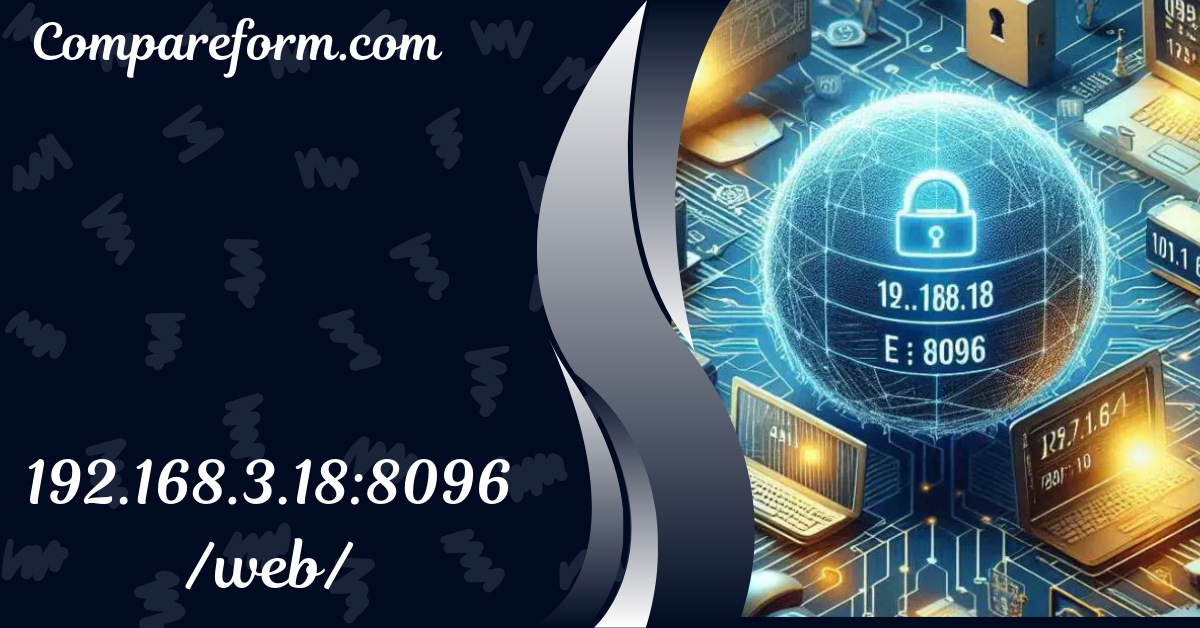“192.168.3.18:8096/web/” – Understanding and Navigating Your Local Network
In today’s digital age, managing and understanding your home or office network is crucial. One common term that pops up for many network administrators or tech enthusiasts is “192.168.3.18:8096/web/.”
While this might seem like a string of numbers and symbols, it plays a significant role in how devices within a local network interact. This article will dive deep into what “192.168.3.18:8096/web/” means, how it works, and why it’s essential to grasp its significance for your network’s efficiency and security.
Introduction to “192.168.3.18:8096/web/”
The term “192.168.3.18:8096/web/” may appear cryptic, but it represents a common aspect of managing and interacting with devices on a local network. At its core, this term relates to an IP address combined with a port number and a web interface path.
This combination is typically used to access the web-based interface of a service running on a local device, such as a media server, a router, or any networked device that requires a graphical user interface (GUI) for management.
Key Takeaways:
- 192.168.3.18 is a private IP address, not accessible from the public internet.
- 8096 is a port number, which directs the traffic to a specific service running on the device.
- /web/ is the path to the web interface, where users can manage or interact with the service.
Understanding IP Addresses: What is 192.168.3.18?
What is an IP Address?
An IP (Internet Protocol) address is a unique identifier assigned to devices on a network. Just like a home address, an IP address allows devices to find and communicate with each other. There are two types of IP addresses: public and private.
What is a Private IP Address?
Private IP addresses, like 192.168.3.18, are reserved for use within private networks, such as a home or office. These addresses are not routable on the public internet, meaning they cannot be accessed directly from outside the local network.
The Role of 192.168.x.x Addresses
The 192.168.x.x range is commonly used for private networks. The most well-known address in this range is 192.168.0.1, typically used by routers. However, 192.168.3.18 serves a similar purpose but is designated for a different device or service within the local network.
Why Use 192.168.3.18?
192.168.3.18 might be automatically assigned by a router’s DHCP server, or it could be manually configured for a specific device. This address is unique within the local network, ensuring that data intended for this device reaches it correctly.
Related Terms to Know:
- DHCP (Dynamic Host Configuration Protocol): Automatically assigns IP addresses to devices on a network.
- Subnet: A segment of a network that shares a common address component.
The Role of Port 8096 in Network Communication
What is a Port Number?
A port number is a way to identify a specific process or service running on a device. When combined with an IP address, it tells the network where to send data.
For example, while the IP address might direct traffic to a specific computer, the port number ensures that the data reaches the right application on that computer.
Why Port 8096?
Port 8096 is often used by services such as media servers (e.g., Emby), which provide a web interface for managing media libraries, streaming content, and configuring server settings.
The choice of port 8096 is somewhat arbitrary, but it is usually selected to avoid conflicts with more common ports like 80 (HTTP) or 443 (HTTPS).
Accessing Services via Port 8096
To access a service running on port 8096, you would enter the IP address followed by the port number in your web browser’s address bar, like this: http://192.168.3.18:8096/. This tells the browser to connect to the device at 192.168.3.18 and interact with whatever service is running on port 8096.
Related Terms to Know:
- HTTP/HTTPS: Protocols for transferring data over the web.
- Port Forwarding: A technique used to allow external devices to access services on a private network.
Web Interfaces and Their Importance in Local Networks
What is a Web Interface?
A web interface is a user interface that allows users to interact with a service through a web browser. It provides a graphical way to manage devices, configure settings, and monitor performance.
Why Use Web Interfaces?
Web interfaces are crucial because they simplify the management of networked devices. Instead of using command-line tools or proprietary software, users can configure and control devices directly from a web browser. This is especially useful for devices like routers, network-attached storage (NAS), or media servers.
The “/web/” Path
The “/web/” path in “192.168.3.18:8096/web/” usually indicates the location of the web interface files on the server. When you access this URL, the server delivers the necessary HTML, CSS, and JavaScript files to your browser, allowing you to interact with the device’s interface.
Related Terms to Know:
- GUI (Graphical User Interface): A visual way to interact with a computer or device.
- HTML/CSS/JavaScript: The core technologies used to build web interfaces.
How to Access “192.168.3.18:8096/web/”
Step-by-Step Guide to Accessing the Web Interface
- Ensure the Device is Powered On: The device assigned the IP address 192.168.3.18 must be on and connected to the local network.
- Connect to the Same Network: Make sure your computer or smartphone is connected to the same local network as the device.
- Open a Web Browser: Use any modern web browser like Chrome, Firefox, or Edge.
- Enter the URL: In the address bar, type http://192.168.3.18:8096/web/ and press Enter.
- Log In if Necessary: If the web interface is protected, you may be prompted to enter a username and password.
- Navigate the Interface: Once logged in, you can manage the device or service using the options available on the web interface.
Common Issues When Accessing 192.168.3.18:8096/web/
- Incorrect IP Address: Ensure you are using the correct IP address. If the device’s IP has changed, update the URL accordingly.
- Firewall Settings: Some devices may have a firewall that blocks access to the web interface. Adjust the firewall settings if necessary.
- Service Not Running: Ensure that the service associated with port 8096 is running on the device.
Related Terms to Know:
- Login Credentials: Username and password used to access the web interface.
- Firewall: A security system that controls incoming and outgoing network traffic.
Troubleshooting Common Issues
Unable to Access 192.168.3.18:8096/web/
1. Verify Network Connection
- Ensure that your device is connected to the correct local network. A simple check is to see if other devices on the same network can access the web interface.
2. Check the Device’s Status
- Ensure the device at 192.168.3.18 is powered on and connected to the network. You might need to restart it if it’s unresponsive.
3. Use the Correct IP Address
- Sometimes, the device’s IP address may change, especially if it’s assigned dynamically via DHCP. You can find the current IP address by logging into your router and checking the list of connected devices.
4. Firewall or Antivirus Interference
- Your firewall or antivirus software might be blocking access to port 8096. Temporarily disable these programs to see if access is restored.
5. Browser Issues
- Try accessing the web interface using a different browser or clear the cache of your current browser.
Web Interface Loads Slowly or Not at All
- Network Traffic: High network traffic can slow down the web interface. Try accessing the interface during off-peak hours.
- Device Overload: If the device at 192.168.3.18 is handling too many tasks, it might slow down the web interface. Restarting the device can help.
- Outdated Software: Ensure both your browser and the device’s firmware/software are up-to-date.
Login Issues
- Forgotten Credentials: If you can’t remember the login credentials, you may need to reset the device or use a password recovery option if available.
- Account Lockout: After too many failed login attempts, some devices lock the account temporarily. Wait a few minutes before trying again.
The Security Implications of Using “192.168.3.18:8096/web/”
Understanding Security Risks
Using “192.168.3.18:8096/web/” for accessing a local web interface is generally safe, but it’s essential to be aware of potential security risks.
Common Security Threats
- Unauthorized Access: If someone gains access to your local network, they could potentially reach the web interface at 192.168.3.18:8096/web/. Ensure that your network is secured with a strong password.
- Default Credentials: Many devices come with default login credentials that should be changed immediately. Leaving default credentials in place is a significant security risk.
- Exposed Services: If port forwarding is configured on your router to expose 192.168.3.18:8096/web/ to the internet, it can become a target for hackers. Use strong passwords and consider additional security measures like VPNs.
Best Practices for Securing Your Network
- Change Default Passwords: Always change the default username and password to something secure.
- Use Strong Network Security: Ensure your Wi-Fi network is secured with WPA3 or at least WPA2 encryption.
- Keep Firmware Updated: Regularly update your devices’ firmware to patch any security vulnerabilities.
- Disable Unused Services: If you’re not using the service associated with port 8096, consider disabling it to reduce the attack surface.
Related Terms to Know:
- WPA2/WPA3: Wi-Fi security protocols.
- Firmware: Software programmed into a device’s read-only memory.
Practical Applications of “192.168.3.18:8096/web/” in Home and Office Networks
Home Networks
In a home network, “192.168.3.18:8096/web/” is commonly used to access services like media servers (e.g., Emby or Jellyfin), where users can manage their media libraries, stream videos, and set up remote access for content.
Office Networks
In an office environment, this address might be used to manage various networked devices like printers, file servers, or network storage systems. IT administrators use the web interface to monitor performance, configure settings, and troubleshoot issues.
Media Servers
Services like Emby or Jellyfin often use port 8096 for their web interface, allowing users to access and manage their media libraries from any device on the network.
Router and Network Device Management
Many network devices use similar IP addresses and ports for management interfaces. Understanding how to access and secure these interfaces is crucial for maintaining a stable and secure network.
Related Terms to Know:
- Media Server: A device or software that stores and streams digital media.
- Network Attached Storage (NAS): A device that provides file-based data storage services to other devices on the network.
Frequently Asked Questions (FAQs)
1. What is “192.168.3.18:8096/web/” used for?
It is typically used to access the web interface of a service running on a device within a local network, such as a media server or a network management tool.
2. Can I access “192.168.3.18:8096/web/” from the internet?
No, 192.168.3.18 is a private IP address and is not accessible from the public internet unless you have configured port forwarding on your router.
3. What do I do if I can’t access “192.168.3.18:8096/web/”?
Verify that your device is on the same network, check the IP address, ensure the service is running, and check for any firewall or antivirus interference.
4. Is it safe to use “192.168.3.18:8096/web/”?
Yes, it’s safe if you secure your network, change default passwords, and follow best practices for network security.
5. Why is port 8096 used?
Port 8096 is commonly used by media servers like Emby, as it’s an arbitrary choice to avoid conflicts with more common ports.
Conclusion
Understanding “192.168.3.18:8096/web/” and its role in your local network is crucial for managing and securing your home or office devices.
Whether you’re streaming media from a server, configuring a router, or troubleshooting network issues, knowing how to access and secure this web interface can enhance your control over your network and protect your data.






